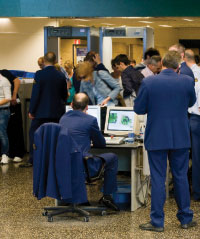
The ACI EUROPE Aviation Security Committee is currently developing a cohesive and coherent overarching strategy for airport security through to 2015 and beyond. Key components are exchange of information/intelligence, ‘passenger differentiation’, targeted use of enhanced detection equipment – including the implementation of LAGs screening equipment and security scanners – and enhancing the capability of the workforce.

The ACI EUROPE Aviation Security Committee is currently developing a cohesive and coherent overarching strategy for airport security through to 2015 and beyond. Key components are exchange of information/intelligence, ‘passenger differentiation’, targeted use of enhanced detection equipment and enhancing the capability of the workforce.
The implementation of the new rules for LAGs is, without question, the most urgent task facing security teams across the EU’s airport network. It was announced last November that restrictions on the carriage of LAGs through EU airports will be lifted via a two-stage process. On 29 April, the European Commission confirmed this, stating that under the first stage of the agreement, from 29 April 2011 any traveller arriving in the EU carrying duty free LAGs sealed inside a STEB (Secure Tamper Evident Bags) that meets ICAO specifications, and with a receipt that shows it was purchased within the last 36 hours, can freely transfer within any airport in the EU. Under the second stage, all LAGs restrictions will be lifted at EU airports by 29 April 2013.
Siim Kallas, European Commission Vice-President for Transport, said “A lot has been learned since the first EU-wide rules putting in place common aviation security standards were put in place after September 11 (2001). This is about building on the experience of recent years and streamlining procedures, so that on a daily basis security controls are easier for industry to implement. For passengers, the aim is also to simplify wherever possible the necessary security controls. In that sense this package takes a significant step forwards in signalling the beginning of the end for the current restrictions on liquids in cabin baggage, with a clear and final deadline of April 2013.”
Therefore, within less than a year, LAGs screening equipment must be purchased and integrated into the screening process – a daunting enough task in itself within such a timeline – but, there is also the added complication that to date, there is no European certification system for the technology. “Meeting the Phase One deadline of the new LAGs regulation will be extremely challenging. On top of the technical and logistical difficulties, airports fear that machines will be outdated before the end of their economical life span. Furthermore, airports must develop a system to select Secure Tamper Evident Bags (STEBs) from third countries and to screen the liquids contained,” explained Kriegbaum. This additional process will require more staff and time than today, and there is a danger that this will actually end up increasing waiting time for all passengers. “To cope with this challenge, we have established a working group to look at the LAGs issue consisting of experts from member airports. In addition, we have implemented working groups to deal with new technology – the so-called Technology Panel – and to optimise the handling of benchmarks and surveys,” said Kriegbaum.
Brian Simpson, MEP, Chairman of the European Parliament Transport Committee, added “In the upcoming three years, EU airports will be required to install new technology capable of detecting liquid explosives, so as to allow for the current ban to be lifted. The restrictions go back to 2006, when UK authorities foiled a transatlantic bomb plot involving liquid explosives. Other envisaged measures are the elimination of double security checkpoints in the EU, simplifying and harmonising procedures and ensuring common minimum standards of security training for aviation security staff.”
However, ACI EUROPE remains extremely concerned at the prospect of the first stage of lifting LAGs restrictions next year. The airport community clearly feels that the objective is unrealistic and unattainable within the proposed timeline and that it might create serious confusion to the detriment of passengers, with a knock-on effect on service levels, especially at airports with high levels of transfer traffic.
New technically advanced, efficient and cost-effective systems and procedures are required. This will not only involve the development of new technology, but also the best use of it. Kriegbaum explained that, for the screening of LAGs, this means that advanced technology alone is not sufficient, if it has not been integrated into the screening process, in a way that actively improves the passenger experience and service level.
Under the current LAGs security rules, travellers arriving in the EU from a non-EU country airport and transferring to another flight are not be allowed to carry LAGs exceeding 100ml on board their next flight, unless arriving from an approved airport with so-called ‘third country recognition’. These LAGs, including duty free/travel value purchases sealed in STEBs, are confiscated. Significantly, passengers flying from the EU with connecting flights at Toronto Pearson International or Montréal-Trudeau International are now able to carry duty free/travel value LAGs purchased at European airports on connecting flights as hand luggage provided that they are packed in STEBs and display clear proof of purchase within the last 36 hours.
Frank O’Connell, ETRC President, said “Canada’s introduction of reciprocity rules for travellers from the EU for Toronto and Montréal is a very welcome step forward. I am particularly pleased to see equivalent rights being granted by Canada to passengers originating in Europe. This follows the recent introduction of a similar agreement with Malaysia and I now hope that the United States will follow Canada’s lead in extending reciprocity to passengers travelling from the EU.”
The US Transportation Security Administration (TSA) is committed to sharing technological developments on the screening of LAGs and collaborative efforts have included informal five-country consultations between the US, Canada, UK, France and Israel to address air cargo and mass transit security, as well as testing and certification of technologies. Cindy Farkus, Assistant Administrator for Global Strategies, TSA, said: “We have been talking about the need to have a harmonised approach and this may have to be a staged approach at hub airports. But it is better to do this together, which will avoid passenger confusion. It depends on the technology being deployed and doing this at the same time will be difficult.”

ACI EUROPE recommends that European, national authorities and airport operators work in close cooperation in order to develop efficient and intelligence-driven processes for border control aimed at promoting a single EU Border Control standard. These processes should be automated and be based on the use of an internationally standardised globally interoperable biometric.
Automated border control
Another key issue on the agenda is automated border control. ACI EUROPE recommends that European, national authorities and airport operators work in close cooperation in order to develop efficient and intelligence-driven processes for border control aimed at promoting a single EU Border Control standard that will reduce security risks while successfully managing passenger flow. These processes should be automated and be based on the use of an internationally standardised globally interoperable biometric embedded in Machine Readable Travel Documents (MRTDs) and on standardised formats of biometric data. “I would welcome automated border control under the security aspect, as it provides for more reliable ID checks than a human being comparing an image with a face. Automated face recognition seems to me the most promising method, with finger biometrics as a fallback,” said Kriegbaum.
ACI EUROPE takes the view that border control is, fundamentally, a national security and immigration issue and, therefore, calls for public funding of the costs needed in order to adapt the infrastructure at its member airports and render it appropriate for the use of automated border control solutions. ACI EUROPE strongly believes that this approach will reduce future operating costs, and at the same time enable control authorities and airport operators to better evaluate potential risks in a coordinated way, while facilitating a rapid and efficient clearance process for passengers.
On the subject of funding for aviation security, Kriegbaum explained that airports have always regarded the fight against terrorism a basic responsibility of the State. “Thus, the ‘user pays’ principle must not be the only way to finance aviation security. In particular when States decide to apply additional security measures over and above those required by EU law, they should bear the cost,” he said. The proposed EU Directive on Aviation Security Charges is now due for review by the Council, following the European Parliament’s recent vote in favour of Member States having to pay for any security measures above the EU-mandated norm. Currently, it is expected that the Council will retain their position of being fervently opposed to States being responsible for security funding.
‘One-stop’ security challenge
Europe’s airports are working diligently to improve security services by redesigning facilities and providing expertise and advice to regulators on the assessment of new initiatives such as ‘passenger differentiation’, as part of a renewed focus on better intelligence. Aviation security of the future will only be efficient if it is targeted. “Which kind of equipment should be used for which purpose? Which procedure is required for which individual? Could it not be possible to apply pure baseline security measures for a number of our customers? Use of intelligence, sharing of information between States and the application of behaviour pattern recognition systems are tools to answer these questions,” explained Kriegbaum.
The present lack of genuine harmonisation both within the EU and worldwide has made the ideal of ‘one-stop’ security all the more remote. The target should be to eliminate all risk at the beginning of the journey or, even better, at an earlier stage by means of intelligence. “There is a need for adequate, but not necessarily identical, security procedures around the world. The less predictable security procedures are, the harder they can be to overcome,” said Kriegbaum.
In terms of improving levels of security while also ensuring a comfortable passenger experience, he added that providing the passenger with all information at the right moment, such as on the way to the airport, would be very helpful. “On the other hand, the more information about him or herself that the passenger is willing to give to the authorities, the easier they can make a risk assessment.”
There needs to be effective harmonisation at EU and ultimately at world level in order to achieve the twin aims of improving security and increasing throughput. Only through genuine harmonisation can the objective of ‘one-stop’ security be achieved. ACI EUROPE insists that this should include a renewed focus on better intelligence and ‘passenger differentiation’. With security currently accounting for up to 35% of European airports’ operating costs and an average 41% of airport staff now security related, it is clear that the situation needs to change. Additional security measures need to be properly funded and the ‘user pays’ principle for financing aviation security has clearly run its course.







